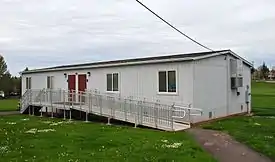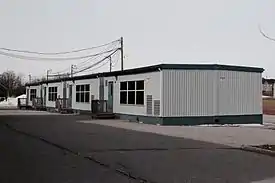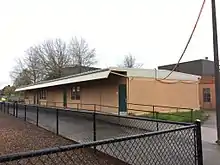Portable classroom
A portable classroom (also known as a demountable or relocatable classroom, portables), is a type of portable building installed at a school to temporarily and quickly provide additional classroom space where there is a shortage of capacity.[1] They are designed so they may be removed once the capacity situation abates, whether by a permanent addition to the school, another school being opened in the area, or a reduction in student population.[1] Such buildings would be installed much like a mobile home, with utilities often being attached to a main building to provide light and heat for the room. Portable classrooms may also be used if permanent classrooms are uninhabitable, such as after a fire or during a major refurbishment.




Sometimes, the portable classrooms are meant to be long-lasting and are built as "portapacks". A portapack combines a series of portables and connects them with a hallway. Portapacks are usually separated from the main building but can connect to the school. In most cases, portapacks are accompanied with a few separate portables.
Portable classrooms are also colloquially known as bungalows, slum classes, t-shacks, trailers, terrapins, huts, t-buildings, portables, or relocatables. In the UK those built during 1945-50 were known as HORSA huts after the name of the Government's post-war building programme, "Hutting Operation for the Raising of the School-leaving Age".[2][3] Others in the UK are often known as 'prattens' or 'Pratten huts' after the former Prattens company that supplied many of them after World War II.[4][5][6][7]
Occupant health and building durability issues
Portable classrooms are frequently criticized for presenting mold, moisture, comfort and unhealthy environment issues. However, when portable classrooms are properly set up and operated, experience has shown that they can present a very long useful life, low maintenance, and healthy, comfortable environments for all occupants.
In the United States, there are approximately 300,000 portable classrooms in use. About half of those are school-owned and of unknown age. The other half are owned by modular leasing companies and are between 5 and 6 years old on average.
If properly installed and maintained, a portable can have a useful life of approximately 30 to 50 years. Certain factors impact useful life, including capital improvements and the number of times a unit is relocated.
A portable classroom can be any number of modular sections wide and typically has only a single level, but can be more than two stories high.
See also
References
- "Relocatable buildings". New Zealand Ministry of Education. Retrieved 26 February 2014.
- Turner, Ben (1 August 2011). "Wirral's last 'temporary' post-war Horsa school hut to be bulldozed to allow Overchurch Infants revamp". Retrieved 24 July 2018.
- Webb, Simon (1 February 2013). The Best Days of Our Lives: School Life in Post-War Britain. History Press. ISBN 9780752489360. Retrieved 24 July 2018 – via Google Books.
- "BBC - Error 404 : Not Found". Archived from the original on 2017-05-22. Retrieved 24 July 2018.
- Webmaster, Wiltshire Council. "My Page". Wiltshire Council. Archived from the original on 24 July 2018. Retrieved 24 July 2018.
- "Pratten Hut – St Dunstan School, Calne, Wiltshire - UK Schools". www.educationandtraining.org.uk. Retrieved 24 July 2018.
- "School website for The Rainbow Pre-School Learning Centre Warminster with Ofsted inspection report". www.findmyschool.co.uk. Retrieved 24 July 2018.
External links
![]() Media related to Portable classrooms at Wikimedia Commons
Media related to Portable classrooms at Wikimedia Commons